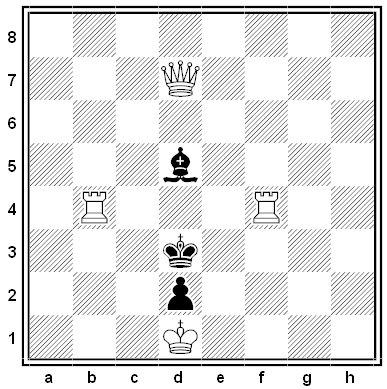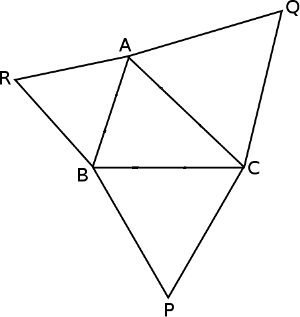
By W.A. Shinkman. This is a self-mate in two moves: White makes a move, Black is allowed to make any legal reply, then White plays a second move that forces Black to checkmate him.

By W.A. Shinkman. This is a self-mate in two moves: White makes a move, Black is allowed to make any legal reply, then White plays a second move that forces Black to checkmate him.
New Year’s Day normally falls one week after Christmas: If Christmas falls on a Thursday, then New Year’s Day will fall on a Thursday as well. What is the most recent year in which Christmas and New Year’s Day fell on different days of the week?
A prison warden greets 23 new prisoners with this challenge. They can meet now to plan a strategy, but then they’ll be placed in separate cells, with no means of communicating. Then the warden will take the prisoners one at a time to a room that contains two switches. Each switch has two positions, on and off, but they’re not connected to anything. The prisoners don’t know the initial positions of the switches. When a prisoner is led into the room, he must reverse the position of exactly one switch. Then he will be led back to his cell, and the switches will remain undisturbed until the warden brings the next prisoner. The warden chooses prisoners at his whim, and he may even choose one prisoner several times in a row, but at any time, each prisoner is guaranteed another visit to the switch room.
The warden continues doing this until a prisoner tells him, “We have all visited the switch room.” If this prisoner is right, then all the prisoner will be set free. But if he’s wrong then they’ll all remain prisoners for life.
What strategy can the prisoners use to ensure their freedom?

Draw an arbitrary triangle and build an equilateral triangle on each of its sides, as shown.
Now show that AP = BQ = CR.

Three hockey pucks, A, B, and C, lie in a plane. You make a move by hitting one puck so that it passes between the other two in a straight line. Is it possible to return all the pucks to their original positions with 1001 moves?
A problem from the 1994 Italian Mathematical Olympiad:
Every inhabitant on the island of knights and scoundrels is either a knight (who always tells the truth) or a scoundrel (who always lies). A visiting journalist interviews each inhabitant exactly once and gets the following answers:
A1: On this island there is at least one scoundrel.
A2: On this island there are at least two scoundrels.
…
An-1: On this island there are at least n – 1 scoundrels.
An: On this island everyone is a scoundrel.
Can the journalist decide whether the knights outnumber the scoundrels?

This pleasing cryptarithm, by Bob High, appears in the September/October 2014 issue of MIT Technology Review. If each letter stands for a digit, what arithmetic sum is enciphered here?